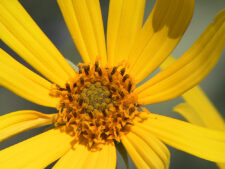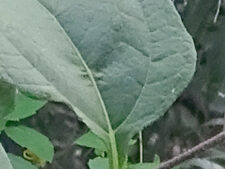
JERUSALEM ARTICHOKE
Helianthus tuberosus
SUNFLOWER FAMILY (Asteraceae)
 Identification
Identification
- Flowering time - August, September
- Uncommon on floodplain at FF & NW
- Tall sunflower with flat, yellow center
- Broad leaves often with winged leaf stalk
- See comments for comparison with other sunflowers with flat, yellow centers
This native perennial with stout, branched, rough-haired stems 3-10 feet tall arises from tuber-bearing roots. Oval to broadly lance-shaped, leaves 4-10 inches long (A,B) are very rough above and downy below, narrowing quickly at the base into a winged stalk (D). Lower leaves are opposite but the upper ones are alternate. Numerous yellow flower heads from 2 to 4 inches across, with 12-20 petal-like ray florets surrounding a flat, yellow central disk with many tiny disk florets occur at the ends of the branches (C).
Found in moist soils along streams, woodland edges, prairies and roadside ditches, flowering in August and September. It is uncommon on the floodplain at Fontenelle Forest and Neale Woods.
Rough, sandpapery stems and broader leaves separate Jerusalem Artichoke from other “flatheads” with a yellow disk, such as Maximilian (Helianthus maximiliani) and Sawtooth Sunflowers (Helianthus grosseserratus), which flower at the same time. Its preference for moist lowland sites, larger size, more numerous branches and flower heads, and winged leaf stalk are helpful in separating it from Hairy Sunflower (Helianthus hirsutus), a plant of upland woods and edges.
The French explorer, Champlain, reported cultivation of this plant for its edible tubers by Native Americans as early as 1605. Gilmore states they were an important food source for local tribes as well. Lewis and Clark dined on tubers Sacagawea dug when in present day North Dakota, and they are still marketed commercially as a vegetable.
More than one explanation for the title Jerusalem exists. Perhaps the best one indicates it is a modification of girasole, the Italian word for sunflower. The artichoke-like taste of the tubers likely prompted the last half of its common name, believed by some to have originated with Champlain. It has a number of other common names including Sunroot, Sunchoke, Topinambur and Earth Apple.
The content of NatureSearch is provided by dedicated volunteer Naturalists of Fontenelle Forest who strive to provide the most accurate information available. Contributors of the images retain their copyrights. The point of contact for this page is: Neal Ratzlaff.



